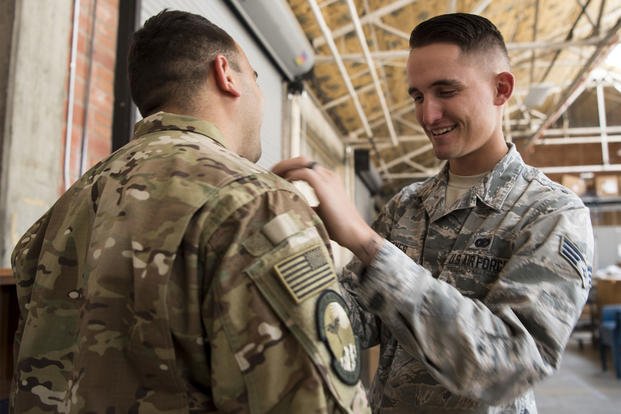Unit patches for the new Operational Camouflage Uniform will be limited to just four colors, Air Force officials said last week.
The colors, according to Air Force spokeswoman Capt. Carrie Volpe, are spice brown, Bagby green, olive drab and black. "There are no exceptions," she said in a recent email.
The switch from the Airman Battle Dress uniform to the OCP restored the option for airmen to wear unit patches on their sleeves. Some patch wear was phased out when the battle dress uniform was authorized in 2007, according to a recent Air Force release.
"Since ABUs did not authorize the wearing of patches, [and] as new units were established, emblems became second thought," said Air Force Materiel Command historian Jack Waid.
"Now that patches are again authorized, units with emblems are scrambling to put together packages so they can convert these to patches for wear," he said in the release.
Patches will be created from the unit's approved Air Force emblem, according to Volpe. If a unit wants to change its current emblem, it would "need to start with their supervisor or unit commander to consult the base's installation historian" to begin the process, she said.
"Any airman may submit an emblem design idea through their chain of command," she added.
For the initial OCP uniform rollout, Air Force major commands, centers and wings will see patches first, "with groups and squadrons a possibility in the future," according to the Air Force release.
The OCP was approved to be worn full-time beginning Oct. 1. It is expected that all airmen will be wearing the OCP by April 1, 2021.
Come April 2019, all officer rank insignia will be spice brown, except for first lieutenant and lieutenant colonel insignia, which will be black. All enlisted ranks will be spice brown.
Name tapes and ranks will be spice brown for all. Patches will follow suit with the approved colors.
The service updated Air Force Instruction 36-2903, "Dress and Personal Appearance of Air Force Personnel," in July to give airmen guidance on how to properly wear OCPs. Per the AFI:
- No patches or badges can be affixed to the front pockets.
- Rank insignia, name tape and Air Force identification must be displayed. Airmen can sew on or use Velcro backing for Air Force tape, name tape, and rank.
- Airmen must choose between sewing vs. Velcro. They cannot mix sew-on and Velcro tapes or rank.
- Only Velcro patches are authorized on the left and right sleeves of the OCP coat.
- Airmen will wear "a basic configuration" until their unit's patches and badges are reconfigured for the OCP uniform. Leadership may contact the Institute of Heraldry for further guidance.
- A maximum of two organizational or unit patches may be worn on the right sleeve, which could include graduate/pilot test/weapons school or wartime service patches. Airmen must display the U.S. flag patch as one of the two patches on the right sleeve.
- A maximum of two patches may be worn on the left sleeve, which could include duty identifier tabs or functional badges.
- Occupational badges may be worn centered half-an-inch above the Air Force tape; a maximum of two badges may be worn.
- The badge "representing the current position will be worn" first. A second, subsequent aeronautical, space, cyberspace or missile operations badge is optional. Any other occupational or qualification badges and patches are optional.
Local historian's offices are to consult with the Air Force Historical Research Agency's Air Force Instruction 84-105, "Organizational Lineage, Honors and Heraldry," for further approval. Specific Air Force guidance can also be found in AFI 84-101, "Historical Products, Services and Requirement."
"These organizations can answer specific questions regarding what is permissible," Volpe said.
"The AFI clearly defines what is and is not a unit," Waid said. "Major commands, centers, wings, groups and squadrons are units, but directorates, divisions, branches, detachments and operating locations are not. Units have an official lineage and history, and it is the lineage that determines eligibility for a unique emblem and patch design."
He continued, "Most people think an emblem is a patch and a patch is an emblem; this is incorrect. Our office deals with emblems, but once it is converted to cloth to become a patch, it becomes the property of the A1 (Office of Personnel) uniform office.
"A unit's history and lineage goes with an emblem, whereas a patch is a wearable symbol of pride, history, warrior spirit and honor," he added.
According to the Air Force instruction, airmen may not mix and match ABU and OCP uniforms in any way.
-- Oriana Pawlyk can be reached at oriana.pawlyk@military.com. Follow her on Twitter at @Oriana0214.










